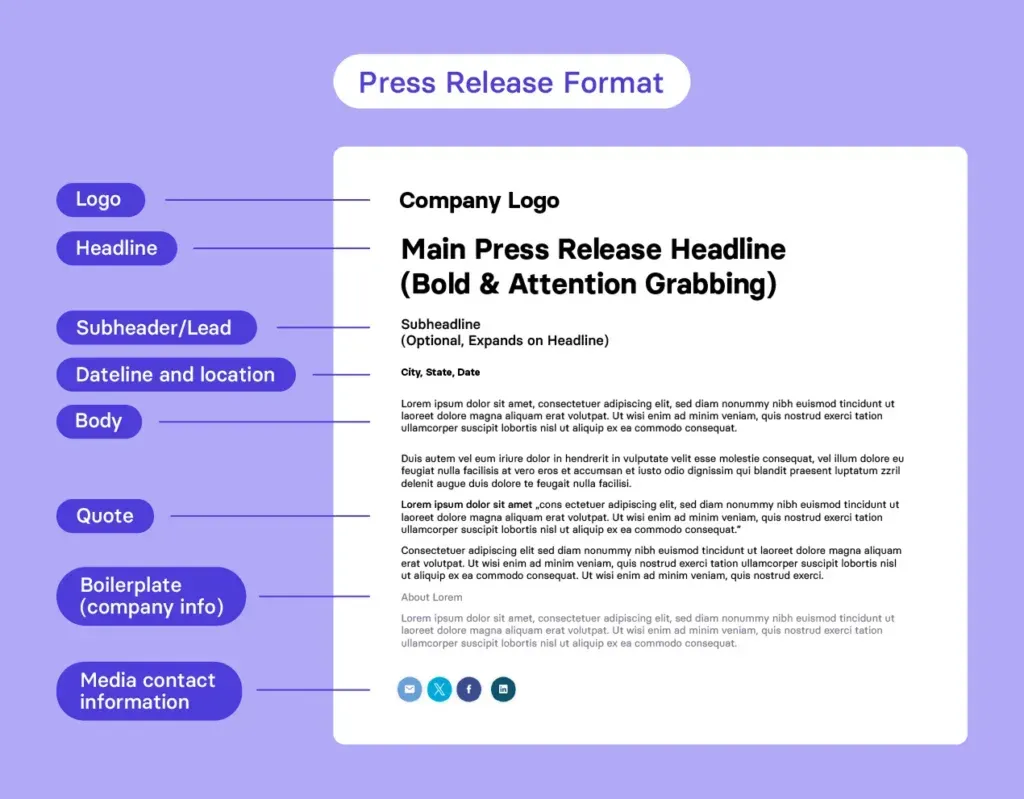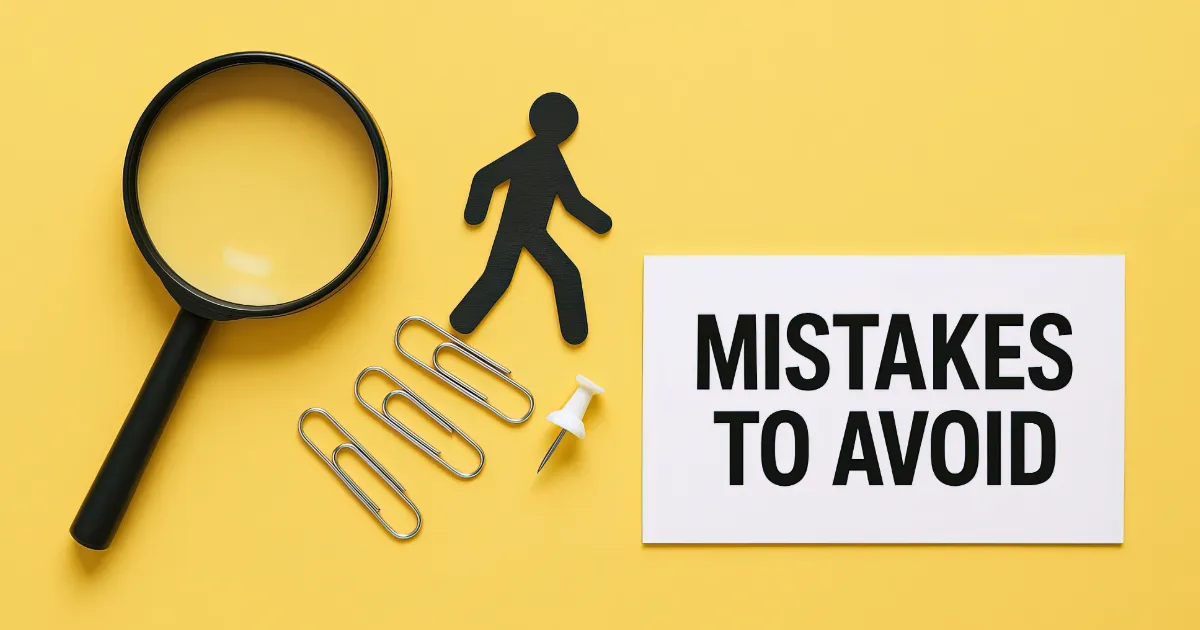September 24, 2025• 9 min read
How Long Should a Press Release Be? Best Layout & Tips
Written by: Grant Oganyan
- How Long Should a Press Release Be? Best Layout & Tips
- What is a press release?
- How long should a press release be
- Optimal press release structure
- Headline and sub-headline
- Dateline
- Body
- Boilerplate
- Contact information
- Multimedia
- Tips to create the perfect press release
- Start with a catchy headline
- Answer the who, what, when, where, and why
- Keep it short and simple
- Include a clear call to action
- Always include contact information
- Use proper structure and formatting
- Common press release mistakes to avoid
- Poor formatting
- Lack of structure
- Burying the main point
- Too many announcements in one release
- Final words
- Frequently asked questions
- Q.1: Why does the length of a press release matter?
- Q.1: What is the best tool to create and format a press release?
- Q.3: What is the ideal structure for a press release?
- Q.4: Who should I send my press release to?
- Q.5: Can I include more than one announcement in a press release?
Learn how long your press release should be to get noticed by journalists. Get expert tips on length, structure, and clarity.

The length of your press release can be the difference between getting media coverage and being completely ignored. The perfect length frequently depends on the kind of announcement you are delivering and the audience we’re addressing. One thing is for sure: capturing attention is not always easy.
The length of your press release can mean the difference between your story being picked up and published or dismissed and ignored. Here, we’ll explore what exactly is the perfect press release length, why it’s so important, and how to ensure that every word counts.
What is a press release?
A press release is a brief, straightforward and professional message that an organization, company or individual shares with the press to announce something newsworthy. It may be about releasing a new product, throwing an event, winning an award or any news that the public would be interested in.
The purpose of a press release is to get the attention of a journalist, blogger, or news site and inspire them to write about it and help spread the word). A good press release provides the basic information - who, what, when and where. It’s basically a way of telling your story to the public via the media.
How long should a press release be
📢 A good press release is usually around 300 to 400 words, which is about one page.
Appropriate length of your press release is vital to getting your news heard. If it's too long, journalists might ignore it completely; at the same time, making it too short might leave out key details.
This way the press release is easily readable, digestible, while keeping all important information front and center. Journalists are often busy, so a press release that is both short and clear increases the odds they will read it and get intrigued in your story.
Optimal press release structure

A clear structure is necessary for a successful press release. Here is the standard format for a clear, concise, yet informative press release:
Headline and sub-headline
Headline is the first thing a journalist or reader will see. So, it needs to grab attention right away. Keep it short, clear, and interesting. Think of it like a newspaper headline. If it doesn’t catch their eye, they might not read any further. Avoid using complicated words or trying to be too clever. Just say what the news is in a simple and direct way.
Just below the headline is the sub-headline. It should be a brief sentence that provides additional context or helps to clarify the primary idea. It’s optional, but really useful to introduce your announcement.
Dateline
The dateline is a tiny line at the top of a press release that informs people where the news is occurring and when it was issued. That helps readers and journalists know whether the news is current and where it’s coming from. It’s a minor role but an important one.
Body
This is where you elaborate on your news more in-depth. The first paragraph should include the five Ws: who, what, when, where and why. Then, you can include any extra details; providing background information, statistics, or the relevance to your audience.
Boilerplate
A boilerplate is a short section you add to the bottom of your press release. It's a short paragraph that quickly informs visitors of your business, what you do, and where they can find out more.
Your company boilerplate is like a mini-bio for your company. Each press release may look a little different, depending on the story, to help journalists understand your story to understand and report it accurately.
💡The company boilerplate acts like a mini bio of your company. It should include a brief, clear description of what the company does, its core values, and key achievements.
Contact information
Don’t forget to include your contacts, it's the primary way journalists will use it to reach out to you! Include the name, email, and/or phone number of someone who can answer media questions, usually your PR representative.
Multimedia
Including images, video or other visual aids in your press release can really help. An image of your product, a short video or maybe even a company logo can help individuals understand it better and make it more interesting.
Visuals help make your press release more professional and polished. Just ensure that files are clear and high-quality, and provide a link or attachment so journalists could easily download them to use in their publications.
Tips to create the perfect press release
💡 Writing a press release does not have to be hard.
You only have to follow a few simple rules to ensure it’s clear, easy to read and interesting. Here are a few basic pointers that can help you write an effective press release even if you’re not skilled in writing:
Start with a catchy headline
The headline is the reader’s first impression, so it should immediately grab their attention. The headline should be short, clear, and tell the main point of your news. Think of it as a newspaper headline: if it's not exciting, no one will continue reading.
Do not use too many jargon or complex words. Simply tell your news, in a way that naturally makes people ask for more.
Answer the who, what, when, where, and why
In the body of your press release you should try to address these five critical questions.
Who is involved?
What is happening?
When is it happening?
Where is it happening?
Why does it matter?
This provides the reader with an overview of news, without having to read the whole story. Journalists are pressed for time, so the sooner they actually “get” your story, the more likely you’ll get a response.
Keep it short and simple
Do not attempt to produce an extensive essay. A press release should get straight to the point. Keep it simple with words and short sentences. Try to fit the whole thing on one page (around 300-400 words). If it’s too lengthy or complex, people may stop reading.
Include a clear call to action
When a reader completes your press release, what do you want them to do? Visit your website? Try your product? Attend an event? Be clear about the next step.
Make sure you have a clear call to action to immediately convert readers to do what you want them to.
Always include contact information
Be sure to include the name, email address and phone number for a contact who can respond to media inquiries. If journalists or bloggers want to reach out to you, they have to be able to find you easily.
Use proper structure and formatting
Press releases have a very specific format and you need to stick to it. Begin with a headline, date, and location, then use the primary paragraph (the 5 Ws), followed by additional details and company boilerplate.
Try to write short paragraphs, clear headings and keep the layout neat. A well-formatted press release appears more professional.
Common press release mistakes to avoid

Even if you do have amazing news to bring to the world, make enough minor failures in your release and no one will touch it. Here’s a look at some things that you should try to avoid:
Poor formatting
People may not even try to understand your press release if it looks like a mess or is hard to read. Also, no long paragraphs, tiny fonts or running wild with styles. Include clear headings with short paragraphs and keep it simple. Make it easy on the eyes.
Lack of structure
A press release must follow basic structure which includes headline, dateline, lead paragraph, body, company boilerplate, and contact details. Keep your news in the right order so it’s easy to follow.
Burying the main point
Don’t save what your news is about for the end, people may not get that far! Put the most important information at the beginning in the first paragraph. In that way, even if someone reads just a bit, they receive the message.
Too many announcements in one release
If you attempt to cover too much at once, your press release can become cluttered and confusing. Focus on one main idea for each press release. If you have more than one piece of news, craft a different press release for each one.
Final words
Whether you're launching a product, announcing an event, or sharing company news, a well-structured press release can get your story the attention it deserves. By following the right format and staying concise, you're giving your news the best shot at media coverage.
Clear, step-by-step formats ensure that busy editors do not get overloaded by information or miss the point. A strong headline and opening paragraph together with supporting details, such as quotes and background information, all help make your news stand out.
Instead of trying to do everything from scratch, consider using online tools that are built specifically for writing and distributing press releases. For instance, Pressdeck simplifies publishing and distributing your press release by giving you an online public news room that is beautifully formatted to give journalists a memorable first impression.
Frequently asked questions
Q.1: Why does the length of a press release matter?
Your press release won’t be read all the way through if it’s overly long, but making it too short might miss the key details. The optimal length for a press release is around 300 to 400 words, or about one page.
Q.1: What is the best tool to create and format a press release?
Many online tools exist that help you create a press release. For example, Pressdeck is an all in one solution that helps you maintain an online press kit with a dedicated branded newsroom. Using these tools you would be able to write, manage, and distribute professional press releases that are always available online.
Q.3: What is the ideal structure for a press release?
Here is the structure for a basic, well-written press release:
Headline and sub-headline – What your news is about.
Dateline – A place and date where the news took place.
Intro paragraph – Includes the 5 Ws (Who, What, When, Where, Why)
Body – Additional information, quotes or background in the click through.
Boilerplate – A brief description of what your company is about.
Media contact information – Name, email, and/or phone of your representative
Optional photos and videos – Important media files that are relevant to your story
Q.4: Who should I send my press release to?
Send your press release to journalists who often cover stories in your niche. Try to be reasonable, if you are only starting out, it might be counterproductive to contact top tier publications without a good reason.
Start with smaller journalists until you build enough online presence and trust to be considered by a larger publication.
Q.5: Can I include more than one announcement in a press release?
It's best to keep one major announcement per press release. Putting too much into one release makes it long, unfocused, and makes it harder to parse what's important.
If you have multiple important news items, feel free to break them up into separate press releases.
Create an online press kit
Make it easier for anyone to learn about your product with Pressdeck






